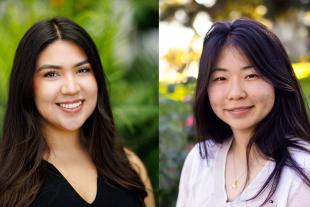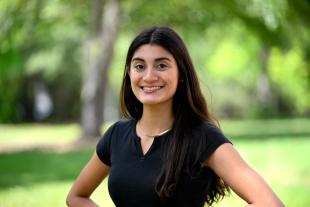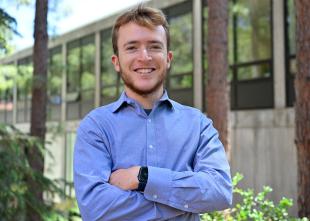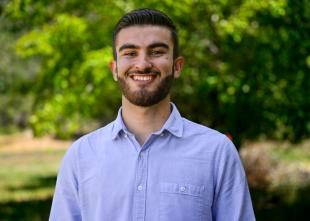‘I Came to Cal Poly for the Challenges.’ One Grad’s Journey from Artist to Civil Engineer
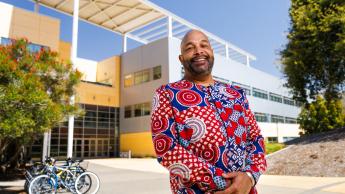
A decade ago, Jon Gausman was a different person.
The father of two — daughter Seinna and son Jaali — was living in San Francisco as an artist, a nightclub bouncer, working to take care of his family. This week, he’s crossing the commencement stage with a bachelor’s degree in civil engineering and master’s degree in civil and environmental engineering. After using every bit of his 46 years of life experience to help others on campus, he’s moving forward with the goal of improving water systems — and quality of life — worldwide.
“I'm on my fourth life right now,” he said. “I've had to shed my skin a few times because it was holding me back. I'm going to shed my skin one more time after this and go on to a new chapter.”
Gausman says his most recent chapter started in Haiti in 2012. He volunteered to go on a service trip to retrofit wells in the hometown of his friend, Antoine, as the country recovered from a devastating earthquake. During three trips to Haiti, he helped fix two wells and taught practical math workshops in the community — all while witnessing how access to clean water was tied to every generation’s ability to be educated, literate and involved in the political process. Where water flowed, Gausman found people could have a remarkably better quality of life.
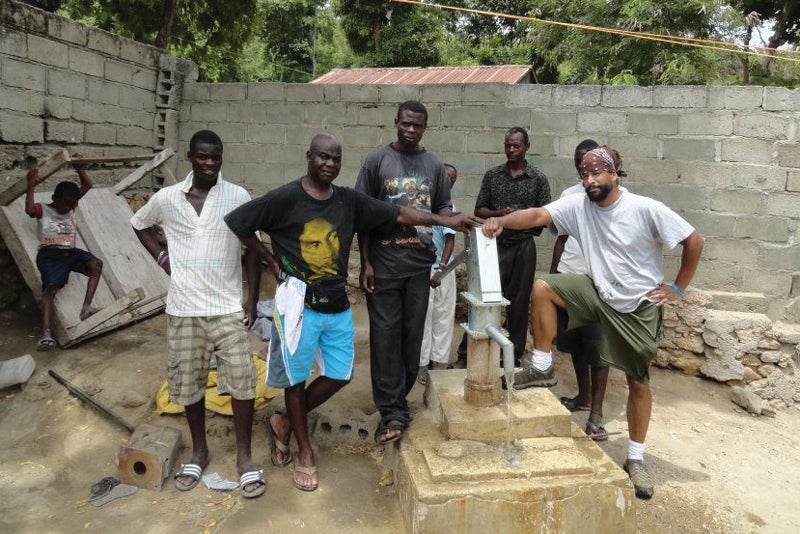
“It’s about health and safety, but it also gets kids in school,” he said. With fresh eyes, he returned to California inspired to take his life in a new direction. After some Googling, he learned what civil engineering was and how better water systems could transform communities both in the U.S. and in developing nations.
“Before I decided to study civil engineering, I hadn't even taken an algebra class,” Gausman said. “I was kind of an artsy person and I wasn't into math or science or anything.
It was just a goal I had: I wanted to help people. This is the best way to do it. And I'm going to bring out whatever parts of myself that need to come out to make this happen. This is my goal, and if I need to build a new skill set, I'm going to go do that.”
After several years taking math and science courses and working with the Black Student Union at City College of San Francisco, Gausman transferred to Cal Poly, a decision he didn’t make lightly.
“I saw myself as a Trojan horse when I came to Cal Poly: I'm going to bring my community with me in my heart or however I can bring them,” he said. “I was really interested in any and everything that the school had to offer — and all the challenges too — because I don't think we grow in the comfort zone.”
He credits an orientation program called CORE (Creating Opportunities for Representative Engagement) for his ability to ease into campus life as a transfer student in the days before Week of Welcome. That connected him to new friends, leaders like Assistant Vice President for Student Affairs Jamie Patton, and cultural and academic support systems.
“It was because of that program that I didn't feel like an outsider,” Gausman said of CORE. “I already had friends, already knew people.”
Many of Gausman’s new friends were younger than his own children. At first, the age difference was a barrier, but a retreat hosted by Cal Poly’s chapter of the National Society for Black Engineers changed everything. Gausman started connecting to his fellow Mustangs, and he realized many were open to hearing about his life experiences and sharing their own.
The challenging stuff is the stuff that really matters — that's when you dig deep.
Jon Gausman
Gausman helped nurture a tight-knit community at the Black Academic Excellence Center (BAEC), where he spent hours talking about books, sharing dishes rooted in Black culture, and dissecting historical events. He bonded with students like Kianah Corey, who helped found a peer-counseling program in the center, by talking about their different life experiences.
“I'm really from a different walk of life compared to a lot of African-American students at the school,” he noted. “I got to be my authentic self and tell them all the times I screwed up when I was their age.”
During his four years at Cal Poly, Gausman widened his view of all the ways he could represent his community and leave campus better than he found it. In addition to his work with NSBE, he held board positions with the Black Student Union; he served on advisory councils for the Dean of Students and Inter Housing Council; he helped found the Men of Color Success Initiative (MOCSI) with the Men & Masculinities program to help close the achievement gap for male students of color, an effort he's most proud of when reflecting on his campus work.
Gausman leaned on the support systems he built when he faltered at a familiar crossroads in the engineering curriculum: dynamics. He admits that he cried when he failed the class and began questioning whether he should go back to his past life checking IDs at a nightclub. But he thought back to his goal — to helping people in Haiti, to lifting up his community in San Francisco and at Cal Poly — and he registered for the class again.
“Sticking to it and trying again taught me a lot about myself,” Gausman said, “and I learned the topic even better.”
One quarter at a time, Gausman began to see how his artistic skills from his previous career helped him become a stronger engineer. He could visualize complex engineering concepts and translate details beautifully in presentations for stakeholders and investors. Some faculty even noted they would keep his work as an extraordinary example for future Mustangs.
With such strong academic momentum, Gausman chose to enter the blended program to earn his master’s degree in civil and environmental engineering as he completed his undergraduate work. This spring, he worked for the San Francisco Department of Public Works in the Bureau of Engineering while completing his master’s thesis on computer modeling and hydrology.
As he dons his cap and gown, he has some sage advice for other Mustangs facing setbacks in their lives:
“You get some tough challenges where you start thinking that because the challenge is tough, this situation isn’t for you. But that's really not how life is. The challenging stuff is the stuff that really matters — that's when you dig deep. I've learned a lot about who I am that I didn't think was possible. I didn't think I could learn science and I did.”
With both degrees in hand, Gausman aspires to fulfill his goal of working internationally to bring clean water to communities struggling to thrive. He plans to return to Haiti for more than brief trips — he says the people there deserve a bigger commitment.
In this next chapter, Jon Gausman may transform again into a state he can’t even imagine yet. But he’ll keep bringing his community with him wherever he goes on his quest to help others.
“This may be the one of the first times in my life I'm really proud of myself in a lot of ways. I'm just really optimistic about my future.”
Read Jon Gausman’s personal essay on his trip to Haiti and journey to engineering in Cal Poly Magazine.
Want more Learn by Doing stories in your life? Sign up for our monthly newsletter, the Cal Poly News Recap!

